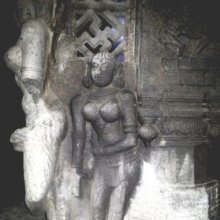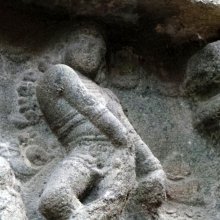Abhugna, Ābhugna: 13 definitions
Introduction:
Abhugna means something in Hinduism, Sanskrit. If you want to know the exact meaning, history, etymology or English translation of this term then check out the descriptions on this page. Add your comment or reference to a book if you want to contribute to this summary article.
Images (photo gallery)
In Hinduism
Natyashastra (theatrics and dramaturgy)
Source: Wisdom Library: Nāṭya-śāstraĀbhugna (आभुग्न, “slightly bent”) refers to a specific gesture (āṅgika) made with the breast (uras), according to the Nāṭyaśāstra chapter 10. The breast is one of the six major limbs (aṅga) used to perform certain gestures (āṅgika). These gestures form a part of the histrionic representation (abhinaya).
Source: archive.org: Natya ShastraĀbhugna (आभुग्न, “slightly bent”).—A type of gesture (āṅgika) made with the breasts (uras);—(Instructions): (the breast) lowered, back high, shoulders slightly bent and at times loose (not stiff).
(Uses): in hurry, despair, fainting, sorrow, fear, sickness, broken heart, touching of cold objects, rains and being ashamed of some act.
Source: Shodhganga: Elements of Art and Architecture in the Trtiyakhanda of the Visnudharmottarapurana (natya)Ābhugna (आभुग्न) refers to one of the “seven movements of the chest” (in Sanskrit Dramas), as conveyed through Āṅgikābhinaya: one of the four divisions of Abhinaya or “ways to convey or represent one’s emotion to others”, according to the Viṣṇudharmottarapurāṇa, an ancient Sanskrit text which (being encyclopedic in nature) deals with a variety of cultural topics such as arts, architecture, music, grammar and astronomy.—The āṅgikābhinaya includes the histrionic representation of the limbs which is simply known as physical gestures. There are five kinds of chest movements accepted by the Viṣṇudharmottarapurāṇa as well as the Nāṭyaśāstra. The terms ābhugna and nirbhugna projects the word bhugna which means being crooked because of illness. The movement called ābhugna denotes the position in which someone acts to be killed by weapon or suffering from heart diseases. The Viṣṇudharmottarapurāṇa speaks that in this position the actor should hold the chest by hand. This posture can be observed even in modern theatrical performances.

Natyashastra (नाट्यशास्त्र, nāṭyaśāstra) refers to both the ancient Indian tradition (shastra) of performing arts, (natya—theatrics, drama, dance, music), as well as the name of a Sanskrit work dealing with these subjects. It also teaches the rules for composing Dramatic plays (nataka), construction and performance of Theater, and Poetic works (kavya).
Ayurveda (science of life)
Source: gurumukhi.ru: Ayurveda glossary of termsĀbhugna (आभुग्न):—[ābhugnaṃ] Slight bending

Āyurveda (आयुर्वेद, ayurveda) is a branch of Indian science dealing with medicine, herbalism, taxology, anatomy, surgery, alchemy and related topics. Traditional practice of Āyurveda in ancient India dates back to at least the first millenium BC. Literature is commonly written in Sanskrit using various poetic metres.
Languages of India and abroad
Sanskrit dictionary
Source: DDSA: The practical Sanskrit-English dictionaryAbhugna (अभुग्न).—a.
1) Not bent or crooked, straight,
2) Well, free from disease.
--- OR ---
Ābhugna (आभुग्न).—a. A little curved or bent.
Source: Cologne Digital Sanskrit Dictionaries: Edgerton Buddhist Hybrid Sanskrit DictionaryAbhugna (अभुग्न).—(a-bhugna), adj. (neg. of Sanskrit bhugna), in °na-kukṣi, adj., having a belly that is not crooked, one of the anuvy- añjana: Mahāvyutpatti 303; Dharmasaṃgraha 84 (°tā); in Mahāvastu ii.44.3 doubtless read abhugnodara for abhagno°; compare the synonym ajih- makukṣi Lalitavistara 107.4.
Source: Cologne Digital Sanskrit Dictionaries: Shabda-Sagara Sanskrit-English DictionaryAbhugna (अभुग्न).—mfn.
(-gnaḥ-gnā-gnaṃ) 1. Straight, not bent. 2. Well, free from disease. E. a neg. bhugna broken.
Source: Cologne Digital Sanskrit Dictionaries: Cappeller Sanskrit-English DictionaryĀbhugna (आभुग्न).—[adjective] bent, curved.
Source: Cologne Digital Sanskrit Dictionaries: Monier-Williams Sanskrit-English Dictionary1) Abhugna (अभुग्न):—[=a-bhugna] mfn. not bent, straight
2) [v.s. ...] free from disease, well.
3) Ābhugna (आभुग्न):—[=ā-bhugna] mfn. (√1. bhuj), a little curved or bent, [Raghuvaṃśa]
Source: Cologne Digital Sanskrit Dictionaries: Goldstücker Sanskrit-English DictionaryAbhugna (अभुग्न):—[tatpurusha compound] m. f. n.
(-gnaḥ-gnā-gnam) 1) Straight, not bent.
2) Well, free from disease (Wilson). E. a neg. and bhugna.
Source: Cologne Digital Sanskrit Dictionaries: Yates Sanskrit-English DictionaryAbhugna (अभुग्न):—[a-bhugna] (gnaḥ-gnā-gnaṃ) a. Straight, not bent; well.
[Sanskrit to German]
Sanskrit, also spelled संस्कृतम् (saṃskṛtam), is an ancient language of India commonly seen as the grandmother of the Indo-European language family (even English!). Closely allied with Prakrit and Pali, Sanskrit is more exhaustive in both grammar and terms and has the most extensive collection of literature in the world, greatly surpassing its sister-languages Greek and Latin.
Kannada-English dictionary
Source: Alar: Kannada-English corpusAbhugna (ಅಭುಗ್ನ):—[noun] a posture in Bharata nāṭya (a variety in Indian classical dance) with bent chest, humped back, and dropped shoulder.
Kannada is a Dravidian language (as opposed to the Indo-European language family) mainly spoken in the southwestern region of India.
See also (Relevant definitions)
Starts with: Abhugnakukshi, Abhugnakukshita, Abhugnasaktha.
Ends with: Avabhugna, Prabhugna, Vyabhugna.
Full-text: Abhugnakukshita, Abhugnasaktha, Vyabhugna, Ajihmakukshi, Prabhuj, Heart disease, Crooked, Abhugnakukshi, Illness, Nirbhugna, Uras, Anuvyanjana, Bhuj.
Relevant text
Search found 4 books and stories containing Abhugna, Ābhugna, A-bhugna, Ā-bhugna; (plurals include: Abhugnas, Ābhugnas, bhugnas). You can also click to the full overview containing English textual excerpts. Below are direct links for the most relevant articles:
Vishnudharmottara Purana (Art and Architecture) (by Bhagyashree Sarma)
1.3. Elements of Drama (c): Bodily Movements < [Chapter 3 - Drama and Dance]
Natyashastra (English) (by Bharata-muni)
Gati in Theory and Practice (by Dr. Sujatha Mohan)
Gati in aerial sphere < [Chapter 3 - Application of gati in Dṛśya-kāvyas]
Gati in vehicles < [Chapter 3 - Application of gati in Dṛśya-kāvyas]
Gati in classical dance form of Oḍissi < [Chapter 4 - Practice of Gati]
The Mahavastu (great story) (by J. J. Jones)
Chapter II - Asita and the young Gotama < [Volume II]

